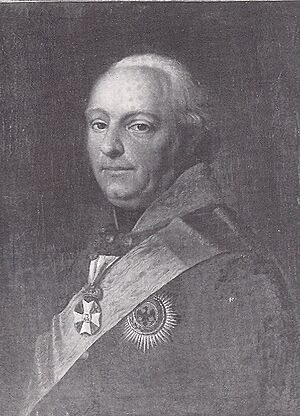Friedrich Ludwig, Prince of Hohenlohe-Ingelfingen facts for kids
Quick facts for kids
Frederick Louis
|
|
|---|---|
| Prince of Hohenlohe-Ingelfingen | |

Frederick Louis, Prince of Hohenlohe-Ingelfingen
|
|
| Born | 31 January 1746 |
| Died | 15 February 1818 (aged 72) Slawentzitz, Upper Silesia |
| Noble family | House of Hohenlohe-Ingelfingen |
| Spouse(s) | Countess Amalie von Hoym |
| Issue | August, Prince of Hohenlohe-Öhringen Prince Adolf zu Hohenlohe-Ingelfingen |
| Father | Heinrich August, 1.Fürst zu Hohenlohe-Ingelfingen |
| Mother | Countess Wilhelmine Eleonore of Hohenlohe-Oehringen |
Frederick Louis, Prince of Hohenlohe-Ingelfingen (German: Friedrich Ludwig Fürst zu Hohenlohe-Ingelfingen) was an important Prussian general. He was born on January 31, 1746, and passed away on February 15, 1818. He is remembered for his military career and his role in the Napoleonic Wars.
Contents
Early Life and Family
Frederick Louis was the oldest son of Henry August, Prince of Hohenlohe-Ingelfingen. His mother was Wilhelmine Eleonore of Hohenlohe-Neuenstein-Öhringen. His family was part of the noble House of Hohenlohe.
Military Career
Frederick Louis started his military journey when he was just a boy. He fought against the Prussians in the last years of the Seven Years' War. After the war ended in 1763, he joined the Prussian army. Because he was a prince, he quickly became a major.
By 1775, he was promoted to lieutenant-colonel. He took part in the War of the Bavarian Succession in 1778. Around that time, he became a colonel. Just before King Frederick the Great died, Frederick Louis was made a major general. He was also put in charge of a regiment.
For several years, he was stationed in Breslau. In 1791, he became the governor of Berlin. In 1794, he led a group of soldiers in the Prussian army near the Rhine river. He showed great bravery in many battles. He was especially noted for his actions at the Battle of Kaiserslautern on September 20.
At this time, Frederick Louis was very popular among Prussian soldiers. Even Blücher, another famous general, praised him.
Facing Napoleon
In 1806, Frederick Louis was a general of infantry. He was chosen to lead the left side of the Prussian army against Napoleon. He had Prince Louis Ferdinand of Prussia under his command.
However, Frederick Louis felt he was more of a prince than a professional soldier. He let his quartermaster-general, a colonel named Christian Karl August Ludwig von Massenbach, influence him too much. Soon, disagreements arose between Frederick Louis and the main commander, the Duke of Brunswick.
The armies moved around without clear plans. Finally, Napoleon's forces nearly destroyed Frederick Louis's army. This happened at the Battle of Jena on October 14, 1806.
Frederick Louis showed his usual courage during the battle. He managed to gather some of his soldiers near Erfurt. From there, he tried to retreat into Prussia. But the French army chased them closely. Marshal Joachim Murat caught his soldiers at Prenzlau.
On October 28, Frederick Louis refused to surrender twice. However, the fighting at the Battle of Prenzlau went badly for the Prussians. Massenbach, his chief of staff, told him that the French had completely surrounded them. This was not true. Influenced by Massenbach and Murat's false promise of 100,000 French soldiers, Frederick Louis surrendered. He gave up with 10,000 men. In reality, Murat had only about 12,000 soldiers nearby.
Frederick Louis's surrender had a bad effect on other Prussian commanders. Many lost hope and followed his example. This led to more surrenders, like the capitulation of Pasewalk and the capitulation of Stettin. Küstrin also surrendered, and the Siege of Magdeburg ended in a surrender. Other Prussian strongholds also fell.
Later Life and Death
After being a prisoner-of-war in France for two years, Frederick Louis returned home. He went to Sławięcice Palace (Schloss Slawentzitz) and lived quietly on his estates. He stayed out of public life until he passed away.
In August 1806, just before the War of the Fourth Coalition began, he had given up his principality to his oldest son. He did not want to become a ruler under Württemberg control.
Frederick Louis died in Slawentzitz in Upper Silesia in 1818. His sons, August, Prince of Hohenlohe-Öhringen and Prince Adolf zu Hohenlohe-Ingelfingen, took over his family's leadership.
Family Life
On April 8, 1782, Frederick Louis married Countess Marie Amalie Christiane Charlotte Luise Anna von Hoym. She was the daughter of Count Julius Gebhard von Hoym. They had several children together:
- Prince August of Hohenlohe-Ingelfingen: He married Louise of House of Württemberg.
- Princess Adelheid of Hohenlohe-Ingelfingen (1787-1858): She married Prince Georg Ludwig Moritz of Hohenlohe-Kirchberg.
- Princess Emilie of Hohenlohe-Ingelfingen (1788-1859): She married Count Albrech August Ludwig of Erbach-Fürstenau.
- Prince Wilhelm Ludwig Eduard of Hohenlohe-Ingelfingen (1789-1790).
- Princess Auguste of Hohenlohe-Ingelfingen (1793-1821): She married Charles, Landgrave of Hesse-Philippsthal-Barchfeld.
- Prince Ludwig Karl of Hohenlohe-Ingelfingen (1794-1794).
- Prince Adolf of Hohenlohe-Ingelfingen: He married Princess Luise of Hohenlohe-Langenburg.
- Prince Alexander of Hohenlohe-Ingelfingen (1798-1829).
See also
 In Spanish: Federico Luis de Hohenlohe-Ingelfingen para niños
In Spanish: Federico Luis de Hohenlohe-Ingelfingen para niños

